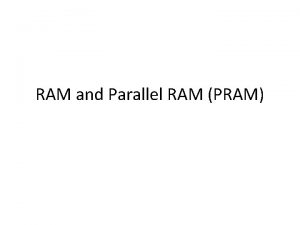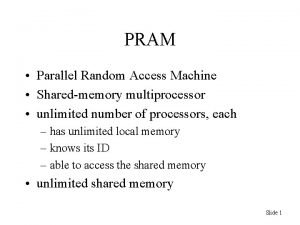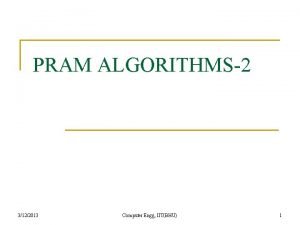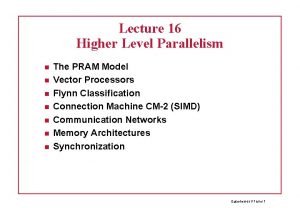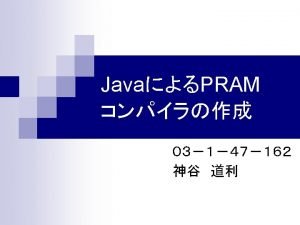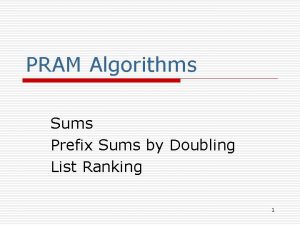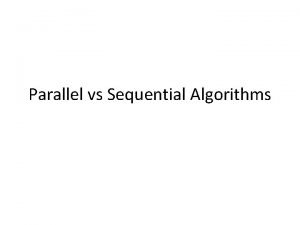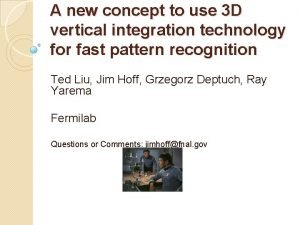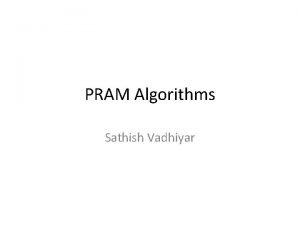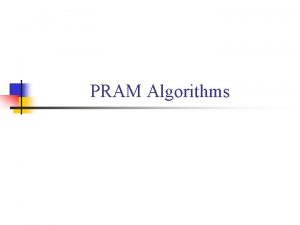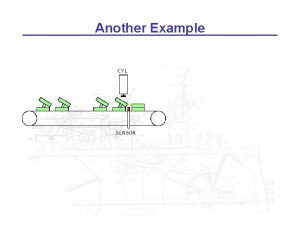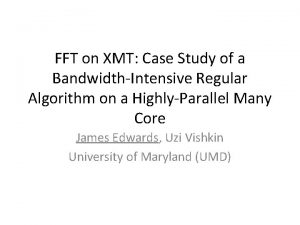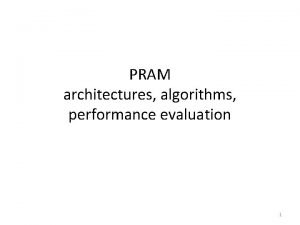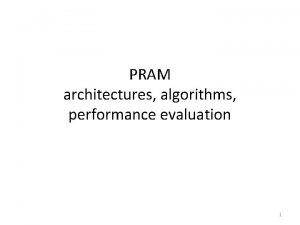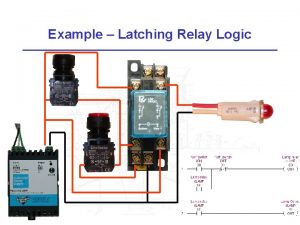XMT Another PRAM Architectures 1 Two PRAM Architectures


















- Slides: 18

XMT Another PRAM Architectures 1

Two PRAM Architectures • XMT: PRAM-on-Chip, by Uzi Vishkin lab – www. umiacs. umd. edu/~vishkin/XMT • Plural Architecture (our own) 2

F&A PS XMT • Fetch and Add instruction – From NYU Ultracomputer • Gottlieb, Grishman, Kruskal, Mc. Auliffe, Rudolph and Snir, “The NYU Ultracomputer - designing an MIMD shared memory parallel computer, ” IEEE Trans. Computers, 32(2): 175– 189, 1983 • Variants: F&Op, F&Incr. • F&I useful to create a list of mutex indices • Parallel execution of F&I is best by prefix-sum 3

Fetch & Add • • A=20 shared variable Pi : x=faa(A, +2) Pk : x=faa(A, +5) Convergence node in MIN: {faa(A, +2), faa(A, +5)} faa(A, +7) Pi P P P +2 MIN M Pk +5 +7 M 20 M M A MIN=Multistage Interconnection Network (logarithmic, e. g. delta or omega networks) 4

Fetch & Add • • A=20 shared variable Pi : x=faa(A, +2) Pk : x=faa(A, +5) Convergence node in MIN: {faa(A, +2), faa(A, +5)} faa(A, +7) A 20+7=27, but returns 20 MIN node decides arbitrarily that Pk came first Pj : x 25 Pk : x 20 Pi P P P +25 MIN M Pk +20 20 M 27 M M A 5

Fetch & Increment • All p processors (or subset) execute indx=f&i(B) P P P • They are assigned the values 0: p-1 in arbitrary order • Same result as prefix sum of an array of all-ones • Takes O(log p) time • This could be used by PRAM algorithms M M 0 M M – Same as faa(B, +1) B 6

Prefix-Sum Hardware • ps hardware dedicated to parallel (synchronized) execution of F&I • Can support any subset of processors • Eliminates need for F&A smart network to main memories Prefix Sum ps Network P P P M M MIN M – Enables simple cache interfaces 7

Simple XMT architecture 8

XMT architecture X. Wen and U. Vishkin. FPGA-based Prototype of a PRAM-On-Chip Processor. ACM-CF’ 08: Computing Frontiers, pp. 55– 66, 2008 9

Example: Vector compact • • Vector A contains many 0’s Wish to compact it to vector B with no 0’s Explicit spawn for A(0: n-1) If non-zero, – request unique index to B – write into B 10

How XMT manages parallelism • Explicit spawn (and join) – Can generate n >> p threads – Execution is NOT synchronized (unlike PRAM) – Execution of thread can happen in any order (e. g. p=1) • Each processor loops: – Executes ps(…) to receive a thread ID – Executes that thread • Data on shared memory, code broadcast • “processors” are actually Thread Control Units – Functional units shared via network • Clustering confuses the picture – Need to split thread IDs into groups (for clusters) • By means of PS bounds – Need to synchronize the clusters 11

The XMT cluster 12

How XMT manages memory access • LS hash unit hashes addresses – Uniform spread – Map large space to small • Where is the cache? global 13

XMT prototype on 3 FPGAs 14

XMT on FPGA tested 64 processors 15

Benchmark 16

SU, hit rate Max SU = 64. Memory-bound and memory-irregular apps: low SU. 17

Exec time comparisons 18
 Another place another time harris burdick
Another place another time harris burdick Parallel random access memory
Parallel random access memory In random access machine, instructions are executed
In random access machine, instructions are executed Pram
Pram Practical pram models
Practical pram models Elements of modern computer system
Elements of modern computer system Nistir 8062
Nistir 8062 Pram model of negotiation
Pram model of negotiation Score pram asthme
Score pram asthme Pram
Pram Pram algorithm for prefix sum
Pram algorithm for prefix sum Parallel vs sequential algorithms
Parallel vs sequential algorithms Pram
Pram Pram model
Pram model Modular product architectures
Modular product architectures Database storage architecture
Database storage architecture Ansi sparc
Ansi sparc Switched backbone networks
Switched backbone networks Autoencoders
Autoencoders

